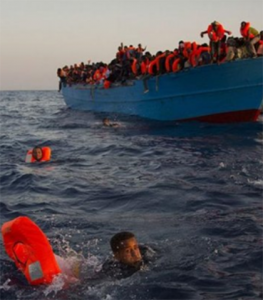Migrant deaths at sea on the rise again
Numbers of deaths among people attempting to reach Europe by irregular sea routes is on the rise, despite border closures due to COVID-19, a new study has found.
At least 1,146 people died attempting to reach Europe by sea in the first six months of 2021 according to a new report by the International Organization for Migration (IOM).
 Deaths along these routes have more than doubled this year compared to the same period in 2020, when 513 migrants were reported to have drowned.
Deaths along these routes have more than doubled this year compared to the same period in 2020, when 513 migrants were reported to have drowned.
The report highlights the ongoing situation along some of the most dangerous maritime migration routes worldwide.
The report says that while the number of people attempting to cross to Europe via the Mediterranean increased by 58 per cent between January and June this year compared to the same period in 2020, more than twice as many people have lost their lives.
“IOM reiterates the call on States to take urgent and proactive steps to reduce loss of life on maritime migration routes to Europe and uphold their obligations under international law,” IOM Director General António Vitorino said.
“Increasing search-and-rescue (SAR) efforts, establishing predictable disembarkation mechanisms and ensuring access to safe and legal migration pathways are key steps towards achieving this goal,” he said.
The report, by IOM’s Missing Migrants Project shows an increase in deaths coupled with insufficient search and rescue operations in the Mediterranean and on the Atlantic Route to the Canary Islands
And it comes at a time when interceptions off the North African coast are also on the rise.
So far in 2021, most of the men, women and children who died trying to reach Europe were attempting to cross the Mediterranean, where 896 deaths have been documented by IOM.
At least 741 people died on the Central Mediterranean route, while 149 people lost their lives crossing the Western Mediterranean and six died on the Eastern Mediterranean route from Turkey to Greece.
In the same period, some 250 people drowned attempting to reach Spain’s Canary Islands on the West Africa/Atlantic route.
But this number may well be an underestimate as hundreds of cases of invisible shipwrecks have been reported by NGOs in direct contact with those on board or with their families.
These cases are extremely difficult to verify and point to the theory that deaths on maritime routes to Europe are far higher than available data show.
The report also shows an increase for the second consecutive year in North African states’ maritime operations along the Central Mediterranean route.
More than 31,500 people were intercepted or rescued by North African authorities in the first half of 2021, compared to 23,117 in the first six months of 2020.
These operations off the coast of Tunisia have increased by 90 per cent in the first six months of 2021 compared to 2020.
Also, more than 15,300 people were returned to Libya in the first six months of 2021, almost three times higher than the same period in 2020.
The report says this is concerning because migrants who are returned to Libya are subjected to arbitrary detention, extortion, disappearances, and torture.
The report also highlights the ongoing data gaps on irregular maritime migration to Europe.
It says better data would help states urgently address their commitments under Objective 8 of the Global Compact for Migration to “save lives and establish coordinated international efforts on missing migrants”.
Read full report here












